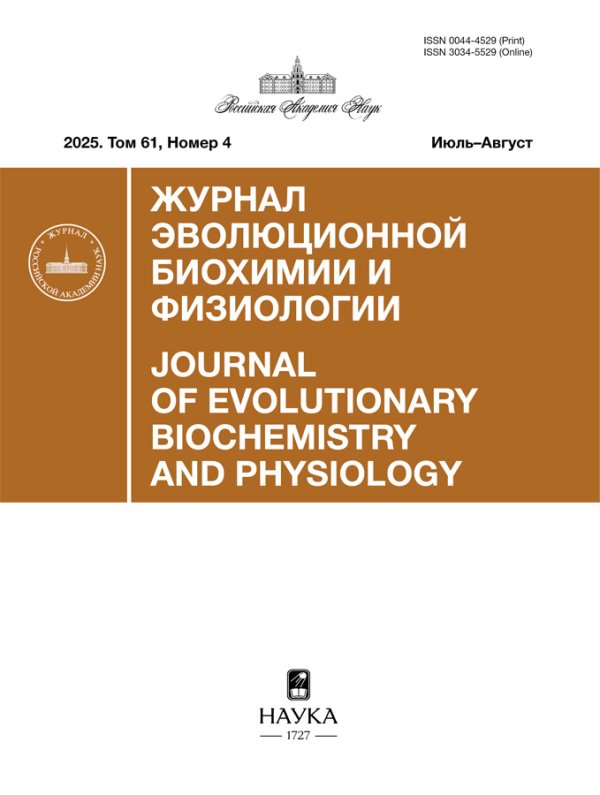Некоторые компоненты серотонинергической системы в глазах двух видов пресноводных моллюсков
- Авторы: Доминова И.Н.1, Хусенова А.А.1, Котова В.В.1, Сидорова М.В.1, Жуков В.В.1
-
Учреждения:
- Балтийский федеральный университет им. И. Канта
- Выпуск: Том 59, № 6 (2023)
- Страницы: 503-513
- Раздел: ЭКСПЕРИМЕНТАЛЬНЫЕ СТАТЬИ
- URL: https://journals.rcsi.science/0044-4529/article/view/247311
- DOI: https://doi.org/10.31857/S0044452923060037
- EDN: https://elibrary.ru/HVCSLT
- ID: 247311
Цитировать
Полный текст
Аннотация
Выполнено маркирование 5-НТ-иммунореактивных структур на срезах глаз пресноводных моллюсков Lymnaea stagnalis и Pomacea canaliculata. В периокулярной области животных обоих видов обнаружена повышенная плотность 5-НТ-ергических волокон, образующих структурно выраженные сплетения и частично проникающих в сетчатку. В тканях глаза обнаружена транскрипция генов рецепторов серотонина: двух типов у L. stagnalis и трех – у P. canaliculata. Ее относительный уровень статистически значимо превышает этот показатель в центральных ганглиях нервной системы и щупальцах. Дополнительно в тканях P. canaliculata была зафиксирована транскрипция гена транспортера 5-НТ. Полученные результаты обсуждаются с позиций возможного серотонинергического механизма модуляции процессов в сетчатке у брюхоногих моллюсков.
Об авторах
И. Н. Доминова
Балтийский федеральный университет им. И. Канта
Email: valerzhukov@mail.ru
Россия, Калининград
А. А. Хусенова
Балтийский федеральный университет им. И. Канта
Email: valerzhukov@mail.ru
Россия, Калининград
В. В. Котова
Балтийский федеральный университет им. И. Канта
Email: valerzhukov@mail.ru
Россия, Калининград
М. В. Сидорова
Балтийский федеральный университет им. И. Канта
Email: valerzhukov@mail.ru
Россия, Калининград
В. В. Жуков
Балтийский федеральный университет им. И. Канта
Автор, ответственный за переписку.
Email: valerzhukov@mail.ru
Россия, Калининград
Список литературы
- Tierney AJ (2018) Invertebrate serotonin receptors: a molecular perspective on classification and pharmacology. J Exp Biol 221(Pt 19): jeb184838. https://doi.org/10.1242/jeb.184838
- Bacqué-Cazenave J, Bharatiya R, Barrière G, Delbecque JP, Bouguiyoud N, Di Giovanni G, Cattaert D, De Deurwaerdère P (2020) Serotonin in Animal Cognition and Behavior. Int J Mol Sci 21 (5): 1649. https://doi.org/10.3390/ijms21051649
- Sizemore TR, Hurley LM, Dacks AM (2020) Serotonergic modulation across sensory modalities. J Neurophysiol 123 (6): 2406–2425. https://doi.org/10.1152/jn.00034.2020
- Yamoah EN, Crow T (1996) Protein kinase and G-protein regulation of Ca2+ currents in Hermissenda photoreceptors by 5-HT and GABA. J Neurosci 16 (15): 4799–4809. https://doi.org/10.1523/JNEUROSCI.16-15-04799.1996
- Razy-Krajka F, Brown ER, Horie T, Callebert J, Sasakura Y, Joly JS, Kusakabe TG, Vernier P. (2012) Monoaminergic modulation of photoreception in ascidian: evidence for a proto-hypothalamo-retinal territory. BMC Biol 10: 45. https://doi.org/10.1186/1741-7007-10-45
- Colwell CS (1990) Light and serotonin interact in affecting the circadian system of Aplysia. J Comp Physiol A 167 (6): 841–845. https://doi.org/10.1007/BF00189772
- Masson J (2019) Serotonin in retina. Biochimie 161: 51–55. https://doi.org/10.1016/j.biochi.2018.11.006
- Kito-Yamashita T, Haga C, Hirai K, Uemura T, Kondo H, Kosaka K (1990) Localization of serotonin immunoreactivity in cephalopod visual system. Brain Res 521 (1–2): 81–88. https://doi.org/10.1016/0006-8993(90)91527-n
- Takahashi JS, Nelson DE, Eskin A (1989) Immunocytochemical localization of serotonergic fibers innervating the ocular circadian system of Aplysia. Neuroscience 28 (1):139–147. https://doi.org/10.1016/0306-4522(89)90238-8
- Michel S, Schoch K, Stevenson PA (2000) Amine and amino acid transmitters in the eye of the mollusc Bulla gouldiana: an immunocytochemical study. J Comp Neurol 425 (2): 244–256. https://doi.org/10.1002/1096-9861(20000918)425:2
- Zhukov VV (2007) On the problem of retinal transmitters of the freshwater mollusc Lymnaea stagnalis. J Evol Biochem Phys 43: 524–532. https://doi.org/10.1134/S0022093007050118
- Zhukov VV, Tuchina OP, Meyer-RochowVB (2012) Serotonin immunoreactivity in the eye and optic nerve of pulmonate gastropod molluscs. J Evol Biochem Phys 48: 471–473. https://doi.org/10.1134/S0022093012040123
- Sugamori KS, Sunahara RK, Guan HC, Bulloch AG, Tensen CP, Seeman P, Niznik HB, Van Tol HH (1993) Serotonin receptor cDNA cloned from Lymnaea stagnalis. Proc Natl Acad Sci U S A 90 (1): 11–15. https://doi.org/10.1073/pnas.90.1.11
- Gerhardt CC, Leysen JE, Planta RJ, Vreugdenhil E, Van Heerikhuizen H (1996) Functional characterisation of a 5-HT2 receptor cDNA cloned from Lymnaea stagnalis. Eur J Pharmacol 311 (2–3): 249–258. https://doi.org/10.1016/0014-2999(96)00410-4
- Benatti C, Colliva C, Blom JMC, Ottaviani E, Tascedda F (2017) Transcriptional effect of serotonin in the ganglia of Lymnaea stagnalis. ISJ 14 (1): 251–258. https://doi.org/10.25431/1824-307X/isj.v14i1.251-258
- OligoArchitectTM Online. Glossary of Parameters.
- Young AP, Landry CF, Jackson DJ, Wyeth RC (2019). Tissue-specific evaluation of suitable reference genes for RT-qPCR in the pond snail, Lymnaea stagnalis. PeerJ 7: e7888. https://doi.org/10.7717/peerj.7888
- Livak KJ, Schmittgen TD (2001) Analysis of relative gene expression data using real-time quantitative PCR and the 2(-Delta Delta C(T)) Method. Methods 25 (4): 402–408. https://doi.org/10.1006/meth.2001.1262
- Gillette R (2006) Evolution and function in serotonergic systems. Integr Comp Biol 46 (6): 838–846. https://doi.org/10.1093/icb/icl024
- Longley RD, Peterman M (2013) Neuronal control of pedal sole cilia in the pond snail Lymnaea stagnalis appressa. J Comp Physiol A Neuroethol Sens Neural Behav Physiol 99 (1): 71–86. https://doi.org/10.1007/s00359-012-0770-x
- Aonuma H, Mezheritskiy M, Boldyshev B, Totani Y, Vorontsov D, Zakharov I, Ito E, Dyakonova V (2020) The Role of Serotonin in the Influence of Intense Locomotion on the Behavior Under Uncertainty in the Mollusk Lymnaea stagnalis. Front Physiol 11: 221. https://doi.org/10.3389/fphys.2020.00221
- Жуков ВВ, Кононенко НЛ, Панормов ИБ., Борисенко ИЛ (2006) Серотонин изменяет электрические реакции глаза Lymnaea stagnalis на световую стимуляцию. Сенсорные системы 20 (4): 270–278. [Zhukov VV, Kononenko NL, Panormov IB, Borisenko IL (2006) Serotonin izmenyaet elektricheskie reakcii glaza Lymnaea stagnalis na svetovuyu stimulyaciyu. Sensornye sistemy 20 (4): 270–278. (In Russ)].
- Aonuma H, Totani Y, Sakakibara M, Lukowiak K, Ito E (2018) Comparison of brain monoamine content in three populations of Lymnaea that correlates with taste-aversive learning ability. Biophys Physicobiol 15: 129–135. https://doi.org/10.2142/biophysico.15.0_129
- Horváth R, Battonyai I, Maász G, Schmidt J, Fekete ZN, Elekes K (2020) Chemical-neuroanatomical organization of peripheral sensory-efferent systems in the pond snail (Lymnaea stagnalis). Brain Struct Funct 225 (8): 2563–2575. https://doi.org/10.1007/s00429-020-02145-z
- Ivashkin EG, Khabarova MYu, Melnikova VI, Khar-chenko OA, Voronezhskaya EE (2017) Local serotonin-immunoreactive plexus in the female reproductive system of hermaphroditic gastropod mollusc Lymnaea stagnalis. Invertebrate Zoology14 (2): 134–139. https://doi.org/10.15298/invertzool.14.2.06
- Azmitia EC (2007) Serotonin and brain: evolution, neuroplasticity, and homeostasis. Int Rev Neurobiol 77: 31–56. https://doi.org/10.1016/S0074-7742(06)77002-7
- Repérant J, Ward R, Miceli D, Rio JP, Médina M, Kenigfest NB, Vesselkin NP (2006) The centrifugal visual system of vertebrates: a comparative analysis of its functional anatomical organization. Brain Res Rev 52 (1): 1–57. https://doi.org/10.1016/j.brainresrev.2005.11.00
- Rodríguez-Sosa L, Calderón-Rosete G, Villalobos MGP, Mendoza Zamora E, González VA (2006) Serotonin modulation of caudal photoreceptor in crayfish. Comp Biochem Physiol C Toxicol Pharmacol 142 (3–4): 220–230. https://doi.org/10.1016/j.cbpc.2005.10.006
- Aréchiga H, Bañuelos E, Frixione E, Picones A, Rodríguez-Sosa L (1990) Modulation of crayfish retinal sensitivity by 5-hydroxytryptamine. J Exp Biol 150: 123–143. https://doi.org/10.1242/jeb.150.1.123
- Calderón-Rosete G, Flores G, Rodríguez-Sosa L (2006) Diurnal rhythm in the levels of the serotonin 5-HT1A receptors in the crayfish eyestalk. Synapse 59 (6): 368–373. https://doi.org/10.1002/syn.20252
- Chen B, Meinertzhagen IA, Shaw SR (1999) Circadian rhythms in light-evoked responses of the fly’s compound eye, and the effects of neuromodulators 5-HT and the peptide PDF. J Comp Physiol A 185 (5): 393–404. https://doi.org/10.1007/s003590050400
- Muñoz JL, López Patiño MA, Hermosilla C, Conde-Sieira M, Soengas JL, Rocha F, Míguez JM (2011) Melatonin in octopus (Octopus vulgaris): tissue distribution, daily changes and relation with serotonin and its acid metabolite. J Comp Physiol A Neuroethol Sens Neural Behav Physiol 197 (8): 789–797. https://doi.org/10.1007/s00359-011-0641-x
- Crow T, Bridge MS (1985) Serotonin modulates photoresponses in Hermissenda type-B photoreceptors. Neurosci Lett 60(1):83–88. https://doi.org/10.1016/0304-3940(85)90385-4
- Farley J, Wu R (1989) Serotonin modulation of Hermissenda type B photoreceptor light responses and ionic currents: implications for mechanisms underlying associative learning. Brain Res Bull 22 (2): 335–351. https://doi.org/10.1016/0361-9230(89)90061-0
- Grover LM, Farley J, Auerbach SB (1989) Serotonin involvement during in vitro conditioning of Hermissenda. Brain Res Bull 22 (2): 363–372. https://doi.org/10.1016/0361-9230(89)90063-4
- Seyer JO, Nilsson DE, Warrant E (1998) Spatial vision in the prosobranch gastropod Ampularia sp. J Exp Biol 201 (Pt 10): 1673–1679. https://doi.org/10.1242/jeb.201.10.1673
- Zieger MV, Meyer-Rochow VB (2008) Understanding the cephalic eyes of pulmonate gastropods: A review. Am Malac Bull 26: 47–66. https://doi.org/10.4003/006.026.0206
- Block GD, Khalsa SB, McMahon DG, Michel S, Guesz M (1993) Biological clocks in the retina: cellular mechanisms of biological timekeeping. Int Rev Cytol 146: 83–144. https://doi.org/10.1016/s0074-7696(08)60381-2
- Zhukov VV, Tuchina, OP (2008) Structure of visual pathways in the nervous system of freshwater pulmonate molluscs. J Evol Biochem Phys 44: 341–353. https://doi.org/10.1134/S0022093008030113
- Zaitseva OV (1994) Structural organization of the sensory systems of the snail. Neurosci Behav Physiol 24 (1): 47–57. https://doi.org/10.1007/BF02355652
Дополнительные файлы
















